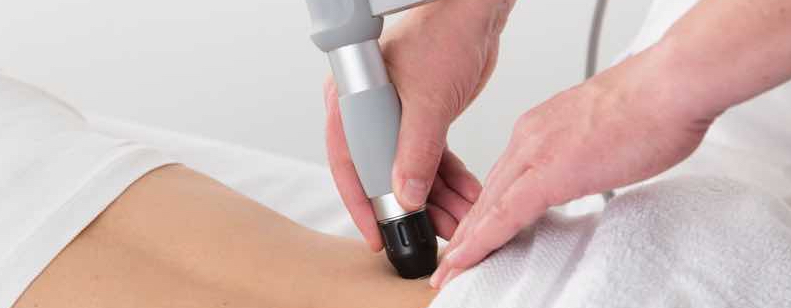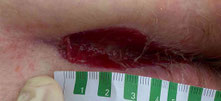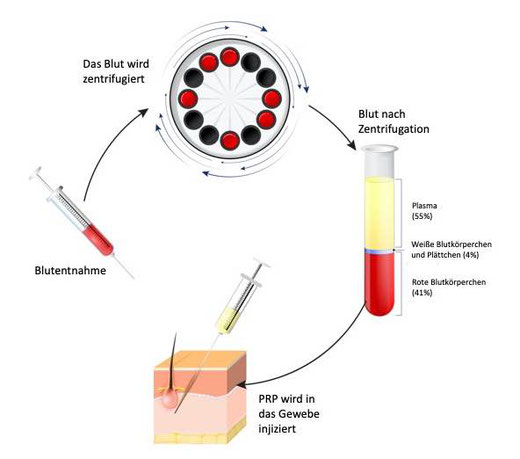Treatments for pilonidal cyst
Often, after initial healing, the wounds suddenly stop closing.
Therefore, bleeding and discomfort occur again and again.
Often, in this situation, a new elimination is recommended, followed by a new wound healing phase.
We always try to avoid this and offer painless, non-surgical methods,
which in many cases lead to a safe closure of the wound.
Shock wave therapy for pilonidal cyst

In addition to the established indications in orthopedics, such as the treatment of calcaneal spurs, tennis elbow or
healing of bone fractures, the shock wave also supports wound healing in chronic wounds or burns.
The shock wave is a new therapeutic option for delayed wound healing after major sinus pilonidalis operations.
A new therapeutic option.
Which wounds are suitable?
- Non-healing wounds such as pilonidal cyst
- Diabetic gangrene
- Ulcus cruris (diabetic)
- Ulcer (non-diabetic)
- Skin burns
- Scars
Advantages of the treatment
- non-invasive therapy
- Hardly any side effects
- No local anesthesia (injections)
- Outpatient treatment
- Long lasting effects
- Short therapy times (8-10 minutes)
How does the shock wave work?
The process of electromagnetic shock wave generation is based on the physical principle of electromagnetic induction, as used in loudspeakers, for example. The arrangement of coil and diaphragm is optimized in such a way that particularly powerful and short acoustic pulses are generated.
Originally, these pulses were used in the early 1980s to break up kidney stones, which is called "extracorporeal shock wave therapy" (ESWT).
In the last 20 years, there has also been a wider therapeutic use in orthopedics, where there is now a wide range of indications for the treatment of musculoskeletal diseases. Here, the costs are also partly covered by the statutory health insurers.
What does a shock wave do in the body?
Treatment with low-energy shock waves leads to blood flow stimulation and also stimulates the formation of new capillary vessels (angiogenesis) through the release of growth factors, which allows the tissue to proliferate and ultimately leads to closure of the defect.
At the same time, a constant energy level and the large focus zone guarantee safe treatment of the wound without pain.
What is the course of treatment with the shock wave in pilonidal cyst?

In the focused shock wave, the patient lies on the abdomen in the case of a non-healing pilonidal sinus. The transducer is held on the wound area and the shock waves are delivered continuously at 50-100 pulses / cm2. The treatment lasts about 8-10 minutes. As a rule, the implementation is not painful.
For a successful therapy at least 6 sessions should be arranged. After that, there is a break with a therapy control after approx. 3 weeks. Afterwards, further sessions can be arranged if necessary. The costs for 6 treatments are about 450 €.
Important: Unfortunately, shock wave therapy is not covered by public health insurance. Therefore, if you wish to receive this therapy, we will be happy to provide you with a cost estimate as an IGeL service (according to the German Fee Schedule for Physicians, GOÄ).
Private insurance patients please inquire with your insurance company about cost coverage prior to treatment.
Treatment should not be performed in patients with tumor disease, pregnancy and therapy with Marcumar or similar blood thinners.
Initial findings

The wound is about 4cm long and 2cm deep. The wound tissue is soft and there is no solid structure. The wound is very sensitive and bleeding occurs quickly.
After 2 weeks

The wound begins to heal from the depth and the length is only 3cm. Bleeding has been rare, the wound tissue in the middle thickens.
After 4 weeks

The wound is healed in depth and superficially there is still a defect of 1.5cm length and 1cm width. It is important to shave at this stage, because hair interferes with wound healing.
"Shockwave therapy has analgesic and anti-inflammatory effects and promotes wound healing through collagen formation."
Platelet Rich Plasma (PRP)

Our blood consists of water, white and red blood cells and platelets.
In autologous blood PRP (Platelet Rich Plasma) therapy, a protein-rich concentrate with growth factors is extracted from the platelets and injected with a special syringe into the appropriate part of the body to be treated, such as the wound healing disorder.
The platelets contain numerous growth factors and cell messengers (cytokines) that serve cell renewal, which is how the PRP treatment gains its regenerative potential and the adjacent tissue is stimulated to grow.
Where can PRP therapy be used?
Classic indications for autologous blood therapy are especially orthopedic clinical pictures such as joint diseases (arthroses), tendonitis and the desired accelerated treatment of bone fractures. These treatments have been practiced for years and are widely established.
In addition, autohaemotherapy is increasingly used in the treatment of chronic wound healing disorders or as an anti-aging therapy in aesthetic medicine. A great advantage is that due to the body's own tissue, there are no side effects in the sense of allergic reactions or inflammations.
A useful application of this therapy is in the administration during surgery to enhance tissue growth from the beginning.
Important: Unfortunately, Platelet Rich Plasma (PRP) therapy is not covered by public health insurance.
Therefore, if you wish to receive this therapy, we will be happy to provide you with a cost estimate as an IGeL service (according to the German Fee Schedule for Physicians, GOÄ). Private insurance patients please inquire with your insurance company about cost coverage prior to treatment.
Treatment should not be performed on patients with tumor diseases, pregnancy and therapy with Marcumar or similar blood thinners.
Which wounds are suitable for PRP?
- Non-healing wounds such as pilonidal cyst
- Anal fistulas
- Ulcus cruris (diabetic)
- Ulcer (non-diabetic)
- Skin burns
- Scars
Advantages of treatment
- Hardly any side effects, since the patient's own blood is free of additives
- No local anesthesia
- Outpatient treatment
- Long lasting effects
- Short therapy time (10 minutes)
How does the PRP treatment work?

After blood collection, the so-called whole blood is immediately placed in a special tube in a centrifuge. No further processing is necessary. The centrifugal force separates the blood into three components.
The uppermost part consists of the blood cells and the platelet-poor part, the plasma, which makes up about 55%. In the middle, the white blood cells (leukocytes) and platelets (thrombocytes) accumulate with about 4% of the total volume. The lowest layer consists of red blood cells (erythrocytes), which clump together to form a blood cake and make up about 41%.
The platelet-rich plasma is drawn from the tubes and injected into the patient's body site to be treated, whereby the added growth factors induce tissue growth and improve healing.

